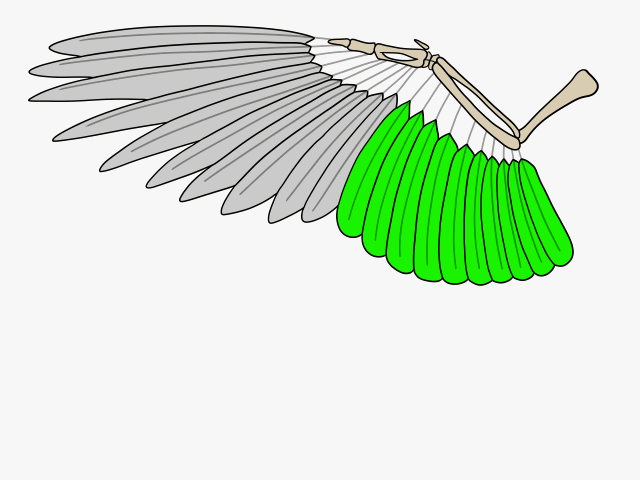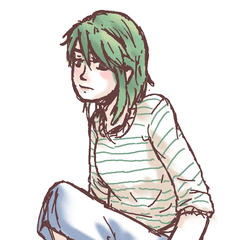Feathered Wings: A Drawing Tutorial
In this tutorial, I'm going to show you how to draw feathered bird wings, and how to apply what you learn to fantasy creatures like griffons.
I'm using the program Clip Studio Paint, but of course you can use any drawing program you want, or even good ol' pencil and paper!
You can watch a video of this tutorial below or, if you prefer a text version, keep scrolling!
It's tempting to draw wings as just a bunch of random feathers, like this:
However, understanding their anatomy will help you create more realistic artwork.
Wing Bones
The first thing to understand about bird wings is the skeleton. It's an arm!
The bones are actually very similar to humans, with a short upper arm bone called the humerus, two bones called the radius and ulna forming the lower arm, a bunch of carpal bones at the wrist, and a set of metacarpals and phalanges forming the hand and fingers.

Knowing the bones of a bird's wing will help you visualize how it folds and extends.
Flight Feathers
It's also key to knowing where the main flight feathers are attached. The flight feathers consist of primary and secondary feathers.
The primaries are attached to the hand bones. Most birds have ten primary feathers on each wing, though that can vary.
The secondaries are attached to the ulna, one of the bones of the lower arm. The number of secondaries varies quite a bit between bird species, anywhere from 6 to over 40!
Something else for an artist to note: There are no feathers directly attached to the upper arm.
Each feather has a rigid shaft down the middle, with individual hair-like structures called barbs branching off of it.
While it depends on the type of bird, the primary feathers usually start out pointed, gradually becoming more rounded toward the body. Depending on species, sometimes the primary feathers have a distinct notched shape. The secondaries are all rounded feathers.
From the underside, the feathers overlap like this, with the outermost feathers on top:
When seen from above, the opposite is true, with the feathers closest to the body on top:
When a bird's wing is folded, the primaries tuck underneath the secondaries, like this:

Wing Muscles
The actual muscle and flesh of a bird's wing aren't that big - again, it's basically an arm! Most of the muscles that power flight are found in the bird's chest instead.
One important feature for an artist to note is the ligament connecting the shoulder to the wrist, which makes this part of the wing appear curved.
Other Feathers - Top of Wing
Right now, our bird's wing is full of holes! That wouldn't work so well for flying.
There's a second row of feathers that cover the gaps, called the greater coverts. They're found on both on the upper and lower sides of the wings. Think of them like a smaller version of the main flight feathers.
You don't need to remember the names of each feather type, of course, but I find it helps!
Here's where things start to differ between the top and bottom of the wing.
On the top, you'll find one more row of distinct coverts covering the secondary wing feathers. These are called the median coverts.
The bird's thumb controls a special set of free-moving feathers called the alula, which help with flight. They appear on the top of the bird's wing, but sometimes they are raised and visible from underneath. I'll show that in my griffon drawing later in this tutorial!
The rest of the wing is covered with smaller feathers called lesser coverts.
The scapular feathers cover the bird's shoulders.
Finally, the tertials close the gap between the secondary flight feathers and the bird's body.
Other Feathers - Bottom of Wing
The underside of the wing is less complex, with the small lesser coverts covering the remainder of the wing.
There are also a set of fluffy feathers called axillaries that appear in the armpit area. You may be able to see the tertials feathers from underneath as well.
I know that all seems pretty complex, but the more you practice drawing them - especially when you use references! - the more natural it'll become. So how do we put it into practice?
Drawing Griffon Wings
Let's add some feathered wings to this fantasy creature I drew, a griffon!
You can download the image above if you'd like to follow along, or I also have a link below where you can download it as a transparent PNG, printable PDF, Clip Studio Paint CLIP, or Photoshop PSD. Here's the link:
If you do try this out, I'd love to see your drawings! Please feel free to tag me @MsRedNebula on Twitter or Instagram with your finished griffon drawing.
Quick tip - most art programs have ways you can imitate sketching on paper.
In Clip Studio Paint, for example, I like to use the pencil tool. I set my layer color to light blue to differentiate my sketches from my finished linework.
For the griffon, I'll start by sketching in the arms, just like I showed you before. I've also added the ligament that connects the shoulder to the wrist.
Then, I pencil in a guide for the overall shape of the wings. Remember that the primary feathers connect to the hand, and the secondary feathers connect to the lower arm.
I'll add another line on each wing as a guide for the greater coverts.
Now, I'll sketch in each set of feathers. I've dropped the opacity of my guides down to better see what I'm doing.
I'll start with the smallest feathers, the lesser coverts, since they overlap most of the others.
Next are the greater coverts. Since we're on the underside of the wings, the outermost feathers will overlap those further in.
Then, I'll draw in the flight feathers. Griffons are half-eagle, and most birds of prey have notched feathers, so that's how I'll draw this guy!
Notice how even the notches follow that same curve as the rest of the wing feathers.
Then, I'll sketch in the other feathers, the axillaries and tertials that fill in the underwing. Sometimes you'll also be able to see the thumb feathers (the alula) raised, as I've drawn here.
Finally, I'll add my final linework and a few little details, and turn off the sketches.
And there you have it - how to add feathered wings to a griffon!
Conclusion
That's it for this one. What else would you like to learn to draw? If you'd like to see more of my art tutorials, please feel free to follow me here or subscribe to my YouTube channel!
And again, if you find this tutorial helpful, I'd love to see your art! Tag me @MsRedNebula on Twitter or Instagram and show me your drawings of winged creatures.
Bye for now!























コメント